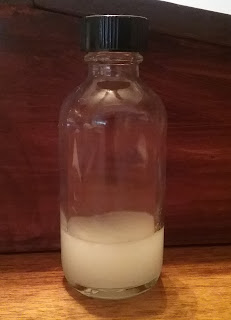Another--French spirits of wine 1 J lbs, essence of bergamot 1 drachm, essence of lemon 1 drachm, English oil of lavender drachm, oil of juniper drachm, oil of neroli 2 scruples. Shake well together occasionally for two or three days when the mixture will be fit for use.Converting from the apothecary measures, that's a proportion of 288 parts spirits of wine: 3 parts bergamot : 3 lemon : 3 lavender : 3 juniper : 2 neroli. I used synthetic neroli scent oil, as the pure neroli (orange flower blossom) oil was cost prohibitive (~$60 for 1/8 oz).
 |
| Eau de Cologne, 1859 version. The oils aren't entirely miscible. |
As advised in the receipt, I've shaken the bottle every day. However, even after a week, it still tends to separate out into a pale yellow layer over a colorless layer. Mixing two not-wholly-mutually-miscible liquids, of course, produces the opaque white mixture seen above.
The scent, like the previous Eau de Cologne I prepared, is rather hard to describe. It's not quite the same, but both are 'greater than the sum of their parts'. Comparing the two, I'm tempted to describe this version as more floral and the first as more citrus-y, but that's far from a complete explanation.
Both receipts contain bergamot and lemon. The first one added lemon balm as well, and used orange flower water where the second had neroli (orange flower) oil. The second calls for lavender oil where the first used lavender-containing Hungary water. The largest difference by component is that this new version uses juniper oil where the first used rosemary (and rosemary-based Hungary water). The first also had traces of sage and thyme in the Hungary water.
No comments:
Post a Comment
Thanks for commenting!